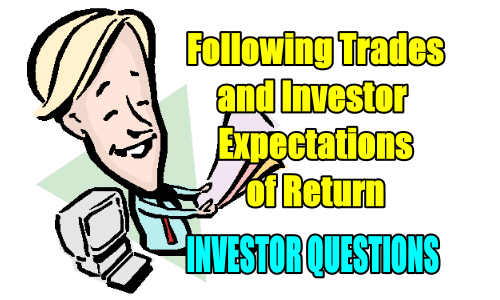 Among the questions often asked are what should an investor expect for his returns against his capital at risk along with what types of trades I tend to do and how trades are communicated to members.
Among the questions often asked are what should an investor expect for his returns against his capital at risk along with what types of trades I tend to do and how trades are communicated to members.
Let’s look at these questions from an investor, followed by some answers.
Investor Questions:
Hi Teddi
Many thanks for the email with the wonderful offer of 12 months membership.
Is it possible that you could let me know how you communicate the trades to the members?
What type of trades are they and on average what ROI% can I expect?
many thanks
Sean
Some Answers
Best Way To Stay In Touch – Twitter Feed
The absolute best way to follow trades is through my Twitter Feed though this link. You can also subscribe via RSS which sends an email to you each time an article is posted or via email but both are slow.
You do not need to be a member of Twitter to follow along but if you want to receive up-to-the-minute notifications, the twitter feed is definitely the best choice. Every trade is posted there first along with every article I write.
You can setup your twitter account to send you text messages (fastest) or emails (slower) if you do not want to keep your Twitter account open during the day.
Many members tell me that they have their twitter feed open on their cell phones throughout the day and receive notifications within seconds of my posting them.
If you are only interested in trade ideas or trade alerts, then just quickly read the short tweet I send as they are marked as a trade alert or trade idea rather than a different article.
Types Of Trades
The majority of my trades are selling options for income, both puts and calls. Selling put options dominates in up markets while selling calls is more common in bear markets as well as sideways markets such as we are seeing develop at present (July 2018).
I tend to stay with credit spreads, both puts and calls, to add in a layer of protection against a large decline.
Second is stock trades based on my Bollinger Bands Strategy Trade. These are short-term stock trades that can last from a day to several weeks depending on the movement of the stock.
Third is the SPY ETF Option trades both put and call, where I trade the SPY ETF intraday for small gains that by the end of a week can add up quickly.
Fourth is the Trade Ahead Of Earnings Strategy which are short-term trades done around earnings announcements.
Fifth are the Super Charge Buy-Write Strategy trades which are trades designed to capture small amounts of premium for short periods of usually just a few hours to a day based on stock momentum and ex-dividend dates.
Last are a variety of trades based on other strategies such as the Getting Ahead Of The Fed Strategy Trades, the Weekly Wanderer Strategy, the Spy Trade Ahead Of The Unemployment Report, the 10-20-30 moving averages strategy and a number of other strategies.
ROI Percentages
What should an investor expect for returns against their capital invested? My goal is being realistic about annual gains. I aim for 12% as a realistic goal every year for my entire portfolio. However it has been rare since 2005 when I have earned less than 20% annually.
In 2009 my portfolio returned 113% but that’s very rare and was a direct result of so many stocks, particularly financial stocks being sold deeply during the credit crisis. In 2010 my portfolio returned 29.86%. Meanwhile 2011 earned 26.8% and 2012 earned 41.7%, while 2013 earned ended with a gain of 58.9%.
2014 saw a return of 52.9% and 2015 was 23%.
I have not yet had time to update 2016 or 2017 but both are over 25% but it is important to be realistic as to what to expect. Honestly 12% a year consistently is an amazing return. Capital compounded at 12% doubles quickly and a small portfolio can become a large one in short order if an investor stays focused and does not continually take losses or withdraw capital for big ticket items such as autos, at the start of building a portfolio. Once a portfolio is over $250,000 it grows quickly and over $500,000 it mushrooms annually. A 25% return on $500,000 is $125,000 for just one year!
The return from each trade varies. Credit put spreads always look great because the capital at risk in a trade is much smaller, so they can often return 5% or more against the capital that is risked in the spread. However I aim to earn no less than 1% in a month for my entire portfolio. Protecting my capital is more important than the return made. If I can earn half a percent in a short-term trade but control the risk to my capital, I prefer the half a percent return for the trade.
Summing Up
Summing up, the best thing I can tell Sean and any investor is that being realistic helps to control losses. Taking time to setup trades and focusing on the strategy being applied is as important as the profit itself. Learning how to protect the capital invested in a trade is equally important. While growing a portfolio is essential, protecting capital is no less paramount to the success of investing hard-earned capital.
Disclaimer: There are risks involved in all investment strategies and investors can and do lose capital. You always trade at your own risk. Read the full disclaimer.
